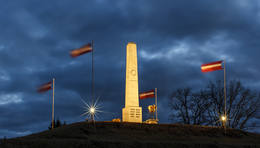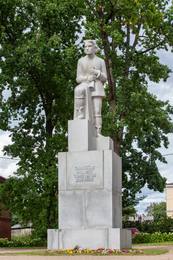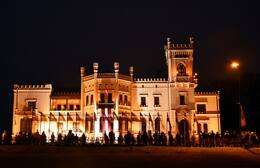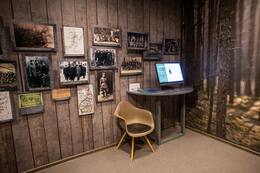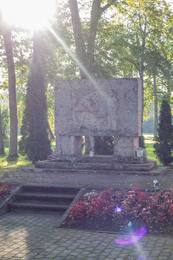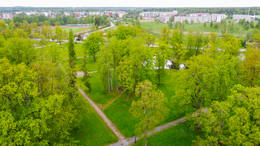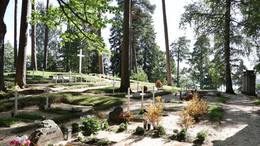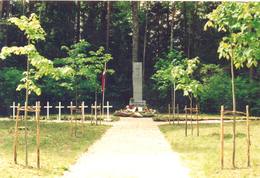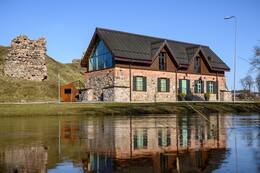7-asis Siguldos pėstininkų pulkas
I Nepriklausomybės karai
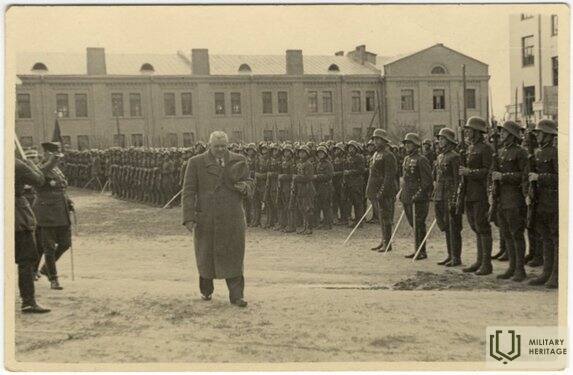
Lemiamo Cėsių mūšio išvakarėse, 1919 m. birželio 20 d., pulkininko Jorgio Zemitano įsakymu, sujungus Šiaurės Latvijos brigados rezervinius batalionus Rūjienoje ir Naukšėnuose, buvo suformuotas 3-iasis Jelgavos pėstininkų pulkas, kuris rugpjūčio 23 d. buvo pervadintas į 7-ąjį Siguldos pėstininkų pulką. Pirmasis šio dalinio vadas buvo pulkininkas leitenantas Oskaras Dankersas. Pulkas buvo priskirtas Latgalos divizijai.
Po formavimo pulkas geležinkeliu buvo perkeltas į Taliną (Rėveli), kur birželio 29 d. gavo 500 šautuvų ir britų laivyno kreiseriu „Dragon“ bei 2 minų ieškotojais buvo pergabentas į Liepoją, kur buvo dislokuotas Kara ostos kareivinėse. 6-oji kuopa liepos 25 d. buvo išsiųsta į Ventspilį, 2-oji kuopa liko Liepojoje, atlikdama garnizono buvimą. Rugpjūčio 30 d. pulkas garlaiviu „Saratov“ buvo perkeltas į Rygą, kur tarnavo kaip garnizonas.
7-asis Siguldos pėstininkų pulkas dalyvavo mūšiuose prieš Bermonto kariuomenę ir Šiaurės Latgalos išlaisvinime. Pulko kariai dalyvavo daugelyje mūšių, įskaitant Katlesi, Vecumi ir Purvmalos stotis, taip pat Jaunlatgalės ir Augšpilio išlaisvinime. Nepriklausomybės karo metu žuvo arba mirė nuo žaizdų 116 pulko karių, o 79 dingo be žinios. 85 pulko kariai buvo apdovanoti Lačplėšio karo ordinu.
Pasirašius Latvijos ir Rusijos taikos sutartį, pulkas liko rytinėje sienoje (Rėzeknėje), kur saugojo sieną nuo Rītūpės stoties iki Estijos sienos, kol atvyko pasienio apsaugos daliniai. 1921 m. sausio mėn. pulkas buvo perkeltas į Alūksnės ir Gulbenės apylinkes. Tų pačių metų balandžio 1 d. pulkas buvo reorganizuotas pagal taikos meto struktūrą. 1923 m. Alūksnėje buvo pastatytos pirmosios dviejų aukštų kareivinės, o 1929 m. – antrosios trijų aukštų kareivinės. 1935 m. Gulbenėje buvo dislokuotas 11-ojo Duobelės pėstininkų pulko batalionas, kuris buvo įtrauktas į pulką kaip ketvirtasis batalionas, todėl 7-asis Siguldos pėstininkų pulkas tapo didžiausiu Latvijos armijos pulku.
Po sovietų okupacijos 1940 m. rugsėjo 10 d. buvo išformuotas 7-asis Siguldos pėstininkų pulkas. Kareiviai buvo priskirti SSRS Raudonosios Armijos 24-ojo teritorinio šaulių korpuso 285-ajam šaulių pulkui.
Daugiau informacijos šaltinių
Siguldos pulko atminimui. 1919 m. birželio 20 d. Siguldos pulko memorialinis fondas, Linkolnas, 1959 m. – p. 231.
Oskaras Dankersas. Kaip tapau 7-ojo Siguldos pulko įkūrėju ir pirmuoju pulko vadu. Straipsnių rinkinys: Ziemeļnieki II, 1974.- http://www.periodika.lv/periodika2-viewer/view/index-dev.html#panel:pp|numeris:/g_001_0306121295|straipsnis:DIVL839|numerio tipas:neapibrėžtas
7-asis Siguldos pėstininkų pulkas – 100. SARGS.LV 2019-06-19. https://www.sargs.lv/lv/vienibas-un-personibas/2019-06-19/7-siguldas-kajnieku-pulkam-100
Susijusi laiko juosta
Susijusios vietos
Paminklas 7-ojo Siguldos pėstininkų pulko kariams, žuvusiems Latvijos Nepriklausomybės kare
Įsikūręs Alūksnės ežero pakrantėje, Pskevo (Kolbergo) gatvės pusėje.
1923 metų birželio 22 dieną Latvijos prezidentas Jānis Čakste atidengė paminklą žuvusiems 7-ojo Siguldos pėstininkų pulko kariams. Paminklą sukūrė dailininkas Jūlijs Miesnieks.
Pulko kariai taip pat gerino ir tvarkė paminklo aplinką. Kareiviai prie paminklo rinkosi pulko metinių minėjimo išvakarėse, kai uždegdavo šventąją ugnį, taip pat pulko metinių dieną po parado ir užtarimo Garnizono kapinėse.
1940/1941 m. bolševikai pašalino ir sunaikino lentą, tačiau pats paminklas buvo nugriautas 1953 m., o jo akmenys įmūryti į kareivinių pastato kampinius pamatus.
Prasidėjus Atbudimui, 1989 m. rudenį buvo sutvarkyta teritorija aplink sunaikintą paminklą, kuris tuo metu dar buvo SSRS okupacinių kariuomenės teritorijoje. Lapkričio 11 d. buvusioje paminklo vietoje buvo atidengtas laikinas granito memorialas su išgraviruotu tekstu: „7-ojo Siguldos pėstininkų pulko paminklas šioje vietoje bus atkurtas 1989 m. lapkričio 11 d.“
Alūksnės brolių kapinių komiteto vadovo U. Veldre iniciatyva buvo pradėti paminklo restauravimo darbai, o restauruotas paminklas atidengtas 2009 m. spalio 16 d.
Skirtingai nuo originalaus paminklo, ant obelisko vietoj pulko krūtinės šarvų buvo sukurtas kryžius. Abu paminklo reljefus nukalė skulptorius Ainārs Zelčs. Restauruotam paminklui panaudotos tiek 22 originalių obelisko blokų dalys, rastos Nacionalinių ginkluotųjų pajėgų pėstininkų mokyklos teritorijoje, tiek naujai pagaminti blokai.
2019 m. birželio 20 d., minint 7-ojo Siguldos pėstininkų pulko šimtmečio jubiliejų, paminklo kalnelio papėdėje buvo atidengta pulko paminklo atminimo vieta ir granito atminimo lenta žuvusiems dalinio kariams, ant kurios išgraviruotas tekstas: „Jūsų stipri dvasia visada su mumis...“. Atminimo vieta pastatyta Nacionalinių ginkluotųjų pajėgų Pėstininkų mokyklos personalo paaukotomis lėšomis.
Paminklas „Talavos trimitininkas“
Įsikūręs Rūjienos centro aikštėje.
Trijų metrų aukščio senovės Latvijos gvardijos kareivio atvaizdas, išdrožtas iš pilko suomiško granito, vadinamas „Tālavo trimitininku“, pastatytas ant trijų metrų aukščio granito pjedestalo, tačiau bendras paminklo aukštis siekia 7,5 metro. Pradiniuose eskizuose ir modeliuose K. Zemdega į kario rankas įdėjo kardą, kuris vėliau buvo pakeistas trimitu. Paminklas buvo atidengtas 1937 m. rugpjūčio 15 d.
Šis paminklas atspindi sunkią mūsų valstybės ir kariuomenės kūrimosi situaciją, taip pat šių įvykių vertinimą. Iškart po Latvijos valstybės paskelbimo prasidėjo Raudonosios armijos puolimas, o laikinoji Karlo Ulmanio vyriausybė rado prieglobstį Liepojoje. 1919 m. vasarį, padedant Estijos armijai, prasidėjo Latvijos išlaisvinimas iš šiaurės, o Rūjienos apylinkėse įvyko pirmosios Tērbate besiformuojančių Latvijos kariuomenės mobilizacijos, kurios, vadovaujamos pulkininko Jorgio Zemitano, tapo Šiaurės Latvijos brigada. Šiaurės Latvijos brigada kovojo ne tik su bolševikais, bet ir su landesveru bei Geležine divizija Cėsių mūšiuose. Rūjienos apylinkėse mobilizuoti Šiaurės Latvijos kariai kovojo ir vėlesniuose Nepriklausomybės karo mūšiuose. Po karo pagrindiniai pergalės laurai atiteko generolui Jāniui Balodžiui ir jo vadovaujamai Pietų Latvijos brigadai, tačiau Šiaurės Latvijos brigada dažnai buvo pamirštama. Rūjienoje planuojamas Šiaurės Latvijos brigados paminklas taip pat užtruko ilgai, o 1937 m. atidengtas paminklas oficialiai buvo reklamuojamas kaip Rūjienos krašto išlaisvinimo ir žuvusių karių atminimo paminklas, nepaminint, kad visi Šiaurės Latvijos brigados pulkai savo ištakas turėjo Rūjienoje.
Paminklas yra ne tik populiari turistų lankoma vieta Latvijos ir Estijos turistams, tam tikru mastu tapusi atspirties tašku norint aplankyti keletą kitų Nepriklausomybės karo memorialinių vietų Rūjienoje, bet „Tālavas tauretājs“ yra ir sustojimo vieta įvairaus lygio Estijos ir Latvijos valstybės bei vietos valdžios pareigūnams.
Rūjienos išlaisvinimo ir žuvusių karių paminklas, geriau žinomas kaip „Tolamas tauretājs“ (Tolimas ragas), 1998 m. spalio 29 d. buvo įtrauktas į valstybės saugomų kultūros paminklų sąrašą kaip nacionalinės svarbos meno paminklas (paminklo apsaugos registracijos numeris 4522).
Alūksnės muziejus
Alūksnės muziejus įsikūręs nacionalinės reikšmės architektūros paminkle – neogotikinėje Alūksnės Naujojoje pilyje, pastatytoje XIX a. pabaigoje. Muziejuje veikia paroda „Totalitarinio režimo aukų memorialinis kambarys“, kurioje pasakojama apie Alūksnės savivaldybės gyventojų likimus Sibire ir Tolimuosiuose Rytuose, o laikotarpis nuo priešistorės iki šių dienų susitinka Alūksnės istorijos ekspozicijoje „Amžių šventė“. Joje yra atskiras skyrius, skirtas 7-ojo Siguldos pėstininkų pulko indėliui į kariuomenę, kultūrą ir visuomenės gyvenimą. 7-ojo Siguldos pėstininkų pulko formavimas prasidėjo 1919 m. birželio 20 d. Naukšėnų dvare. Iš pradžių iš Šiaurės Latvijos brigados rezervinio bataliono buvo suformuota 22 karininkų ir 1580 kareivių kovinė grupė, pavadinta Dankersų divizija. Ji buvo įtraukta į 3-iojo Jelgavos pulko 2-ąjį batalioną. Rugpjūčio 23 d., padidėjus kuopų skaičiui, jis tapo 7-ojo Siguldos pėstininkų pulko dalimi. Dalyvavęs mūšiuose prieš Bermontą, 1920 m. sausio 5 d. pulkas buvo perkeltas į Latgalos frontą kovoti su bolševikais. Pasirašius taikos sutartį su Sovietų Rusija, pulkas saugojo rytinę Latvijos sieną. Latvijos nepriklausomybės kare žuvo daugiau nei 200 pulko karių, o 85 buvo apdovanoti Lačplėšio karo ordinu. 1921 m. 7-asis Siguldos pėstininkų pulkas buvo dislokuotas Alūksnėje. Pulko štabas buvo įsikūręs Alūksnės naujojoje pilyje. Po Antrojo pasaulinio karo pilį perėmė sovietų saugumo institucijos. Nuo šeštojo dešimtmečio pabaigos pilyje buvo įsikūrusios įvairios kultūros įstaigos: Vykdomojo komiteto Kultūros ir kinematografijos skyrius, pionierių namai, biblioteka, kino teatras ir muziejus.
Ekspozicija „Šiaurės Latgala kovose už laisvę“ (Ziemeļlatgale brīvības cīņās)
Muziejus įsikūręs Balvų dvaro komplekse, buvusiame dvaro klėties pastate.
Ekspozicija supažindina su Latvijos Nepriklausomybės kovų istorija iš Šiaurės Latgalos perspektyvos, pasakoja Latgalos partizanų pulko kūrimosi ir veiklos istoriją. Čia eksponuojamos anksčiau niekur nepublikuotos nuotraukos ir dokumentų kopijos, įskaitant 1919 m. liepos 5 d. įsakymą dėl pulko suformavimo. Ypatingą ekspozicijos dalį sudaro 1919 m. liepos–spalio mėn. rusų kalba rašyti vidiniai pulko įsakymai. Jie atskleidžia šio vietinio karinio dalinio formavimosi ypatumus – jame kartu kovojo latviai, latgaliai, rusai ir žydai. Tik pulkui tapus visaverte Latvijos kariuomenės dalimi ir jį papildžius mobilizuotiems kariams iš kitų Latvijos regionų, vidiniai dokumentai pradėti rengti latvių kalba. Ekspozicijoje pasakojama apie Šiaurės Latgalos išvadavimo operaciją. 1920 m. sausio 9–15 d. Latvijos kariuomenės Latgalos divizijos vykdytų mūšių metu buvo išlaisvintos Viliakos, Jaunlatgalės ir Karsavos apylinkės. Galima apžiūrėti su šia operacija susijusius eksponatus, įskaitant ir Lat galos partizanų pulko veiklą Karsavos išvadavimo metu.
Šiaurės Latvijos išvaduotojų paminklas
Įsikūręs Plāčio centre, netoli Inčukalno–Valko greitkelio (A3). Šalia autobusų stotelės ir Straupes bendruomenės centro.
Matomas Teodoro Zaļkalnso sukurtas paminklas Šiaurės Latvijos išvaduotojams Cėsių mūšyje 1919 m.
Ant trijų pakopų pagrindo pastatyti du travertino stulpai, ant kurių remiasi travertino blokas. Jo priekyje bareljefe pavaizduotas arklys, pakinkytas prie plūgo, ir artojas, kuris dešinėje rankoje laiko vadžias, o kairėje – kardą. Paminklo gale iškaltas tekstas, kuris baigiasi poeto Eduardo Virzos eilutėmis:
Šiaurės Latvijos išvaduotojams
KOL ŠIAME LAUKE PASĖJAMAS VIENAS GRŪDAS
Būsite giriami ir gerbiami
Paminklas buvo atidengtas 1931 m. lapkričio 8 d. Atidaryme dalyvavo prezidentas Albertas Kviesis.
Latvijos karinės aviacijos oro uostas
Įsikūręs Vecgulbenės dvaro teritorijoje – istoriniame centre.
Tarpukariu Gulbenėje buvo įsikūręs Latvijos armijos garnizonas, kuriame buvo dislokuotas 7-asis Siguldos pėstininkų pulko batalionas. Ketvirtojo dešimtmečio viduryje pradėta kurti karinė aviacijos bazė, nes sėkmingam karinės aviacijos veikimui net taikos metu turi būti užtikrintas platus aerodromų tinklas. Aerodromai ypač svarbūs tose vietose, kur įkurtos svarbios geležinkelio ir kelių sankryžos. 1935 m. lapkričio 11 d. čia pradėtas karinio aerodromo statymas. 1937 m. Gulbenėje buvo dislokuotas naujai suformuotas Aviacijos pulko dalinys, kuris tapo 6-uoju Latgalos divizijos žvalgybos eskadrile, padidindamas armijos dalinių skaičių prie rytinės Latvijos sienos.
Matosi oranžerijos pastatas.
Alūksnės įgulos kapinės
Įsikūręs Alūksnės ežero pakrantėje, Kapsėtos pusiasalyje, Didžiųjų kapinių teritorijoje.
Jie pradėti kurti ir prižiūrėti 7-ojo Siguldos pėstininkų pulko karių rūpesčiu XX a. 4-ajame dešimtmetyje ir pašventinti 1932 m. lapkričio 11 d. Atkūrus Latvijos nepriklausomybę, Garnizono kapinių priežiūros, su Alūksne susijusių LKOK poilsio vietų nustatymo ir atminimo ženklų Garnizono kapinėse įrengimo ėmėsi Alūksnės brolių kapinių komiteto skyriaus vedėjas Uldis Veldre.
Garnizono kapinėse palaidoti Latvijos Respublikos armijos kariškiai, taip pat kareiviai ir civiliai, žuvę kovose su bolševikais 1941 m. liepos 4 d. Alūksnėje prie Jāņkalninio ir 1941 m. liepos 7 d. Ziemerso valsčiuje prie Prindulių namų.
Daugumoje palaidotųjų yra balti mediniai kryžiai su metalinėmis lentelėmis, kuriose nurodytas mirusiojo vardas, pavardė, rangas ar profesija, taip pat gimimo ir mirties datos.
1990 m. gruodžio 19 d. Garnizono kapinėse buvo atidengta atminimo lenta Lačplėšio karo ordino kavalieriui Viliui Spandegui. Tipinės atminimo lentos taip pat buvo įrengtos LKOK nariams, žuvusiems arba nužudytiems komunistinėse koncentracijos stovyklose ir nepalaidotiems Latvijoje. 1990 m. lapkričio 11 d. buvo įrengta atminimo lenta LKOK nariui Voldemarui Zakiui, žuvusiam komunistinėje koncentracijos stovykloje.
Karvos brolių kapinės
Įsikūręs Alūksnės–Apės kelio pakraštyje, netoli Zuši mājas, į pietus nuo Karvos, ties posūkiu į Rezaką.
Paminklas atidengtas 1937 m. rugsėjo 12 d. Granito stela buvo pagaminta O. Dambekalno akmens karjere Rygoje pagal Karo statybos valdybos architekto Vemerso Vitando projektą.
1975 m. rudenį vietos komunistai paminklą sunaikino. 1989 m. kovo 30 d. Alūksnės rajono taryba priėmė sprendimą paminklą restauruoti, o 1989 m. balandžio 30 d. jo vietoje buvo įrengtas laikinas medinis paminklas – latviško antkapio formos, kurį pagamino Valstybinės elektros gamyklos (VEF) darbininkas Jānis Jaunzemsas. Ant jo buvo užrašas: „Čia bus restauruotas Karvos brolių kapinių paminklas“.
Tuo metu buvo sutvarkytos ir netoliese esančios Brolių kapinės.
1993 m. Alūksnės brolių kapinių komiteto vadovo Uldos Veldre iniciatyva buvo atnaujinti memorialinės vietos restauravimo darbai. Naująjį paminklą pagamino Cėsių akmentašiai broliai Aivaras, Austris ir Auseklis Kerliniai.
Paminklas buvo atidengtas 1994 m. birželio 11 d.
Broliškose kapinėse palaidoti keturi Valmieros pėstininkų pulko 5-osios kuopos kariai - Jēkabs Sukse, Pēteris Leitlands, Ernests Puķītis ir Gustavs Ozols, žuvę mūšiuose prie Zušių 1919 m. balandžio 2 d. Penktasis kareivis, palaidotas XX a. 4-ojo dešimtmečio viduryje, buvo Roberts Glazners, Valmieros pulko karys, dingęs be žinios 1919 m. kovo 31 d. netoli Jaunosios muižos. Iš pradžių jis buvo palaidotas kaip nežinomas, tačiau vėliau jo vardas buvo patikslintas ir iškaltas paminkle. Savo ruožtu penktasis Zušių mūšyje žuvęs karys Augusts Dzedons (Ziedons) palaidotas Apekalnos kapinėse.
Prie paminklo papėdėje įrengta atminimo lenta Ungurių mūšio dalyviui Janiui Goldesui (1891–1952), žuvusiam komunistų koncentracijos stovykloje Intoje, Komijoje.
Antroji atminimo lenta, atidengta 1992 m. rugpjūčio 23 d., yra įrengta prie vieno iš medinių kryžių ir skirta 7-ojo Siguldos pėstininkų pulko kapralui Pēteriui Jansonui, kurį 1941 m. liepos 7 d. nužudė pasitraukiantys komunistai.
Laisvosios valstybės brangenybių namai
Nepriklausomos valstybės palikimą saugantys namai yra šalia Rėzeknės pilies griuvėsių.
Išskirtinėje ekspozicijoje pristatoma keli šimtai istorinių eksponatų iš Latvijos ir užsienio privačių kolekcijų, apimančių 1918–1940 m. laikotarpį, bei skirtingus Latgalos ir Rėzeknės istorijos puslapius. Supažindinama su Pirmosios nepriklausomos Latvijos valstybės karinių ir civilinių apdovanojimų istorija, įvairių valstybinių ir visuomeninių organizacijų veikla, vykusia nuo Latvijos nepriklausomybės karo iki Antrojo pasaulinio karo.
Tai didžiausia Latvijoje kolekcija, pristatanti nepriklausomos valstybės karinius ir civilinius apdovanojimus bei skiriamuosius ženklus.
Antrajame aukšte įrengta keičiamų parodų salė, kurioje bent kartą per metus surengiama nauja paroda. Lankytojai jau turėjo galimybę pamatyti išskirtinę porceliano dirbinių kolekciją, prabangius laikrodžius iš Prancūzijos ir įvairius Latgalos peizažus vaizduojančius paveikslus.
Susijusi istorija
7. Siguldos pėstininkų pulko formavimas
1919 m. birželio 20 d. Naukšėnų dvare, netoli Rūjienos, Šiaurės Latvijos brigados vado pulkininko Jorgio Zemitano įsakymu pradėtas formuoti 7-asis Siguldos pėstininkų pulkas. Iš pradžių iš Šiaurės Latvijos brigados rezervinio bataliono buvo suformuota nedidelė kovinė grupė, susidedanti iš 22 karininkų ir 1580 kareivių, kuri, pagerbiant pirmąjį vadą Oskarą Dankerį, buvo pavadinta Dankerio divizija. Po kelių dienų divizija buvo įtraukta į 3-iojo Jelgavos pulko 2-ąjį batalioną, o rugpjūčio 23 d., pridėjus kuopą, – į 7-ąjį Siguldos pėstininkų pulką.
7-oji Siguldos pėstininkų pulko bermontiada, Didžiosios kunigaikštienės Valijos Veščūnos apdovanojimas Lāčplės karo ordinu Alūksnėje.
Po Latvijos nepriklausomybės karo didžioji seržantė Valija Veščuna už mūšius su bermontininkais prie Plānių namų 1919 m. lapkričio 19 d. buvo apdovanota Lačplėsio karo ordinu. Valija Veščuna buvo viena pirmųjų, perėjusių Lielupės upę, apšaudyta priešo.
Atminimo akimirka Garisono kapinėse
Atkūrus Latvijos nepriklausomybę, Alūksnės brolių kapinių komiteto vadovas Uldis Veldre ėmėsi rūpintis Garnizono kapinių priežiūra, nustatyti su Alūksne susijusias LKOK poilsio vietas ir įrengti atminimo ženklus Garnizono kapinėse.





